Darrell Brooks trial: Prosecutors focus on parade attack victims

Darrell Brooks trial: Waukesha parade's youngest victims the focus of testimony
After testimony Tuesday in the Darrell Brooks trial, the jury knows a lot more about the route prosecutors say he took down Main Street in his red SUV, which went right through some of the youngest people there.
WAUKESHA, Wis. - Testimony in the Darrell Brooks trial shifted for the prosecution team on Tuesday, Oct. 11 as the state began to focus its case on the six fatal victims of the November 2021 Waukesha Christmas Parade attack.
Brooks appeared in a suit and tie Tuesday, as he did Monday. He remained in the main courtroom for the entire day.
As the proceedings got underway, the judge noted a headset would be offered to Brooks again after he complained of being deaf in one ear earlier in the trial. Judge Dorow noted Brooks did not use the headset on Monday when he remained in the main courtroom the entire day after being kicked out every day during the first week of the trial. Dorow said Brooks "seemed to hear fine."
Brooks' 'sovereign citizen' arguments, case law discussed
After that, case law was addressed that Brooks brought up Monday regarding his "sovereign citizen" arguments and his request that the court prove "subject matter jurisdiction."
There were arguments from the state and from Brooks regarding these cases.
Brooks noted that, "I have not been provided with proof of subject matter jurisdiction." Judge Dorow said the court is not required to do that and that this matter had been noted on the record several times before this discussion.
"Even if I were to take these cases as a motion for reconsideration, the cases that I've reviewed don't support that," said Dorow.
Brooks noted, "There's so many things that have yet to even be proven, including that the plaintiff is a human being and not an entity."
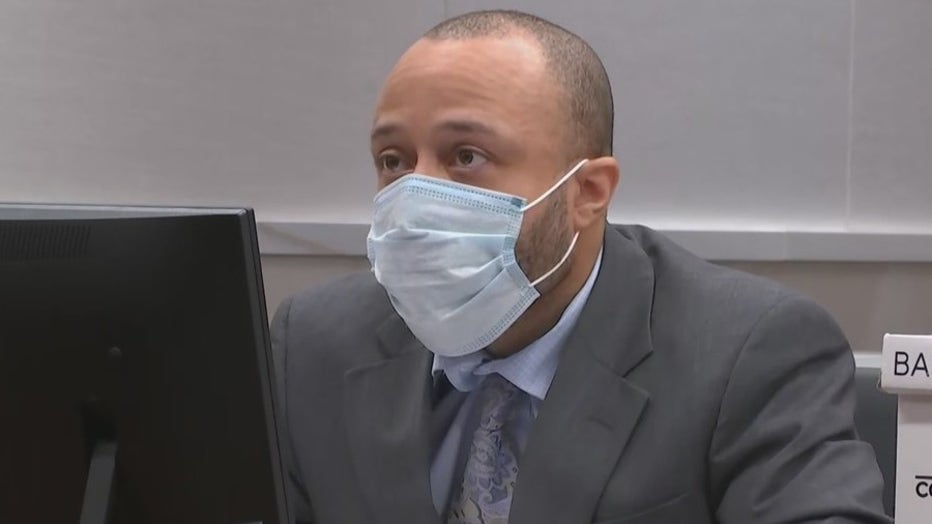
Darrell Brooks in court Tuesday, Oct. 11
The judge said the cases Brooks cited "are not relevant to this case," noting they had to do with federal claims vs. criminal charges brought by a state against an individual. The judge noted one was a criminal case but dealt with a federal law and whether the state had jurisdiction.
Judge Dorow again told Brooks his "sovereign citizen" arguments "have all been debunked throughout the ages in the courts of the United States of America, both in state court and in federal court."
The court subsequently denied Brooks' demands, requests and objections related to this.
Brooks then requested legal reconsideration for the ruling.
The judge said she just went through her reasoning, and Brooks' request was summarily denied with no further argument.
Brooks then asked for a written decision, which was denied.
"This court is not going to explain the law to you, sir," said Judge Dorow. "I've cited the law."
Brooks' subpoenas/witnesses discussed
Also in court Tuesday morning, the state noted 12 subpoenas received from Brooks, and prosecutors said they were working to have all of Brooks' witnesses served and assisting in arranging their appearances in court.
Brooks brought up his 13th subpoena for a parade organizer who has moved to Texas. The judge said Brooks could submit that subpoena to the state, but she added "there's a different procedure for obtaining a witness from out of state." The judge said the person calling that witness (Brooks) would have to make the travel arrangements. On Monday, Brooks told the court that "he's broke" and wouldn't know how to go about arranging travel from jail. The judge said he could at least submit the subpoena so that it would be noted as one that he officially turned over in the case.
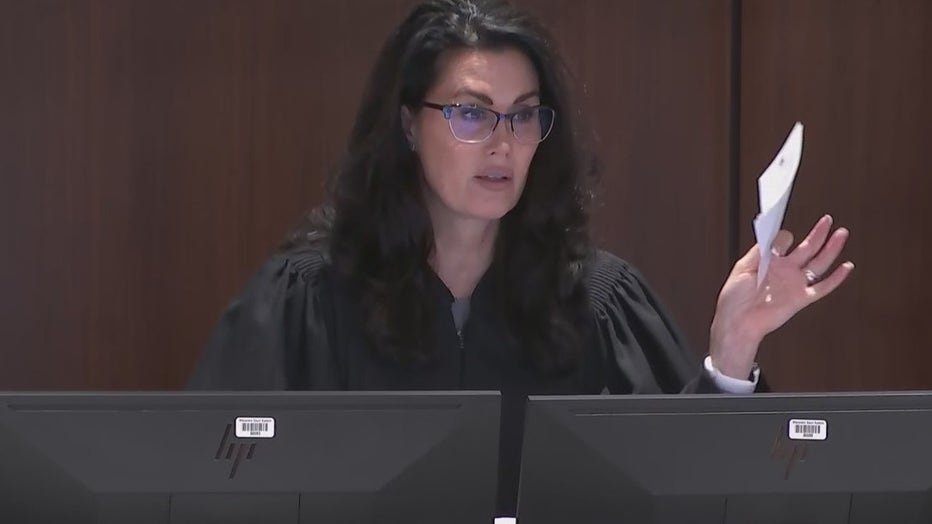
Judge Jennifer Dorow
Need for a Spanish interpreter discussed
There was then a discussion about a need for a Spanish interpreter for one prosecution witness and for one of Brooks' witnesses, Juan Marquez, who was injured in the parade.
The judge advised Brooks he might be required to call that witness out of order (possibly on Wednesday) so that the court could make wise use of the interpreter.
Around 9 a.m., the jury was brought out and the state resumed calling witnesses.
Darrell Brooks trial: Tuesday timeline
Below is a timeline of the events in court Tuesday per court records
8:30 a.m.: Case called for Day 7 of jury trial
Court notes headset given to Brooks again; he did not use it Monday
Brooks' subpoenas filed with the state
Court addresses Brooks' repeated objections to the court's jurisdiction -- state and Brooks made legal arguments
Judge denied Brooks' requests related to jurisdiction
State requested a Spanish interpreter for Wednesday
9:00 a.m.: Jury entered
Kelly Grabow testified for the state -- injured with her daughter in the parade attack
ADA Zachary Wittchow questioned Grabow on direct examination
Brooks cross-examined Grabow
Wittchow re-directed Grabow
Jeff Rogers testified for the state -- Waukesha Blazers coach, two of his three children were hurt in the parade attack
DDA Leslie Boese questioned Rogers on direct examination
Mid-morning break
10:30 a.m.: Jury re-enters
Brooks questioned Rogers on cross-examination
Boese re-directed Rogers
Joshua Kraner testified for the state -- Slammers youth baseball coach, hurt in the parade attack
Boese questioned Kraner on direct examination
Brooks questioned Kraner on cross-examination
11:29 a.m.: Break to discuss legal matters
Brooks asked to discuss his line of questioning during his cross of Kraner -- the judge excused Kraner from further testimony
11:35 a.m.: Jury re-entered
Alyssa Gajewski testified for the state -- Waukesha Xtreme Dance Team coach, 15 members of her group were hurt in the parade attack
12:13 p.m.: Lunch break
Brooks was advised by the court to review statues regarding his hearsay objections
1:34 p.m.: Jury re-entered
Brooks cross-examined Alyssa Gajewski
Wittchow re-directed Gajewski
Jaimie Sutton testified for the state -- Waukesha Xtreme Dance Team coach
Wittchow questioned Sutton on direct examination
Broos questioned Sutton on cross-examination
Michael Carpenter testifies for the state -- Waukesha police detective who conducted video/speed analysis
Wittchow questioned Carpenter on direct examination
Brooks questioned Carpenter on cross-examination
Wittchow re-directed Carpenter
Afternoon break
3:49 p.m.: Jury re-entered
Debora Ramirez testified for the state
Wittchow questioned Ramirez on direct examination
Brooks questioned Ramirez on cross-examination
Wittchow re-directed Ramirez
4:26 p.m.: Jury released for the day
State says they won't need an interpreter; says they will have Brooks' witness who needs an interpreter ready to testify Wednesday afternoon
Judge again notes Brooks did not use a headset Tuesday
Brooks allowed to submit 13th subpoena by Wednesday morning
4:35 p.m.: Court in recess
Kelly Grabow, Waukesha Christmas Parade attendee, testifies
The first person prosecutors called to the stand Tuesday was Kelly Grabow, who was walking in the Waukesha Christmas Parade with her daughter when they were hit and injured. She described their injuries and what she saw and remembered of the incident.
"As I turned all I saw was the hood of the red vehicle," she testified. "I landed and saw the tire roll past my face."
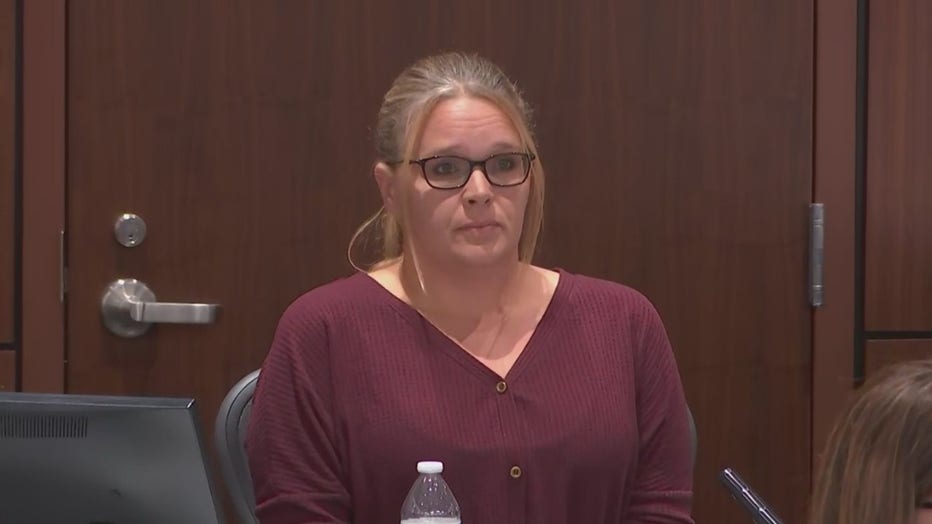
Kelly Grabow
SIGN UP TODAY: Get daily headlines, breaking news emails from FOX6 News
She said she saw her daughter "in the middle of the road...her shoes down the road."
Grabow said she suffered ligament damage to her knee and hand and was treated at the hospital after going to Children's Wisconsin with her daughter. She said she refused to go anywhere before knowing her daughter was safe at home, so she delayed medical attention for her own injuries. She said her daughter sustained bruising down her back, road rash on her face and a broken hand.

Kelly Grabow
During Brooks' cross-examination of Grabow, he asked if she saw the driver.
"No, just the red hood as it ran into me," said Grabow.
She couldn't estimate the speed.
"It all happened so fast…" she said.
She said she didn't hear a horn, and she didn't see if anyone else was struck.
"I did not see anywhere besides the tire going in front of my face," said Grabow.
Grabow also mentioned what she described as the "adrenaline" felt in the moment as she tried to help her daughter and said she heard shots fired.
Jeff Rogers, Waukesha Blazers baseball coach, testifies
The second person called to the stand was Jeff Rogers, the president and coach of the Waukesha Blazers baseball team. Rogers explained the commotion of people running toward him and to the side of the street when he saw a red SUV drive down the parade. He was there with three of his kids, two of whom he said were hurt.
"I remember hearing some sort of scream. I couldn’t tell if it was part of the parade or not," he said.
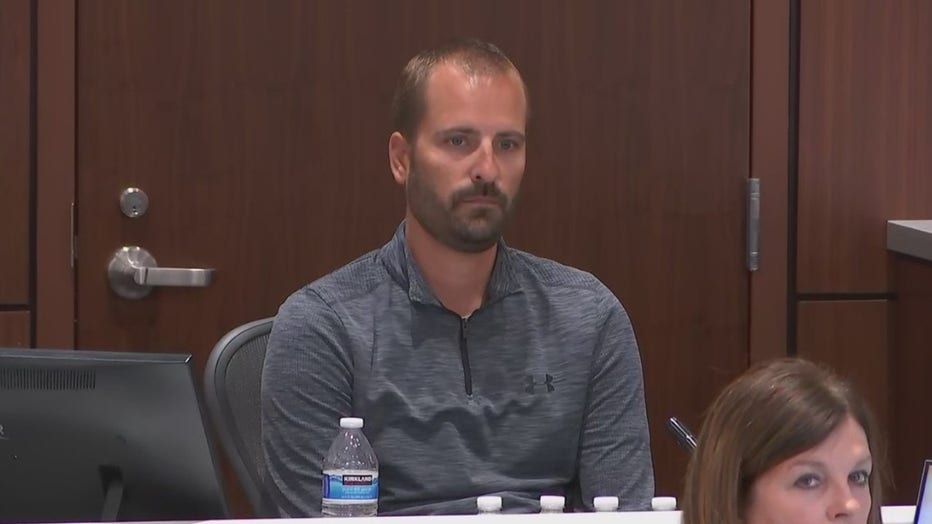
Jeff Rogers
He was asked what he did when he first saw the SUV coming toward him.
"I grabbed my daughter… she slipped out of my hand the first time," he said.
Rogers said his daughter, Riley, was missing after the impact.
The coach described Jackson Sparks, 8, who died at the hospital after the attack, as "motionless on the ground" after the SUV came through. He said he later found out the boy died. He said Jackson's brother, Tucker, who was walking by him at the parade, suffered a head injury.
He said the SUV did not stop. He said shortly after impact, someone said shots were fired, so he and two of his three kids went into a nearby antique store before he went back outside to look for Riley, his missing daughter. He then saw Jackson Sparks on the ground; someone giving CPR to the boy.
After a mid-morning break, court returned to session around 10:30 a.m. Brooks appeared to be wiping tears from his eyes, pulled something from his Bible and said: "I apologize to the witness. I'm a little emotional right now." He then began his cross-examination of Rogers.
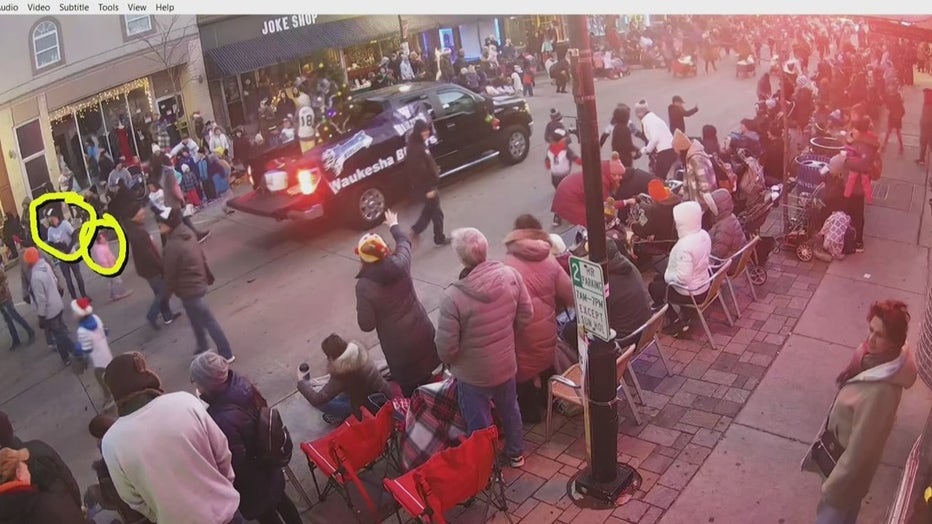
Jeff Rogers
"Is it fair to say nothing about your statement has changed?" Brooks asked Rogers. Rogers answered that everything he said was accurate.
Rogers went on to say he did not see the driver of the red SUV and that he was roughly 10 feet away from it. Brooks asked Rogers why he didn't identify the driver or get the license plate number, to which Rogers answered "because people were being struck."
Brooks asked Rogers why he didn't help any of the injured parties.
"I was concerned about my daughter missing," he said.
Joshua Kraner, Slammers baseball coach, testifies
Joshua Kraner, head coach of the Slammers baseball team, was the third witness called by the state Tuesday. The Slammers were in the parade with the Blazers.
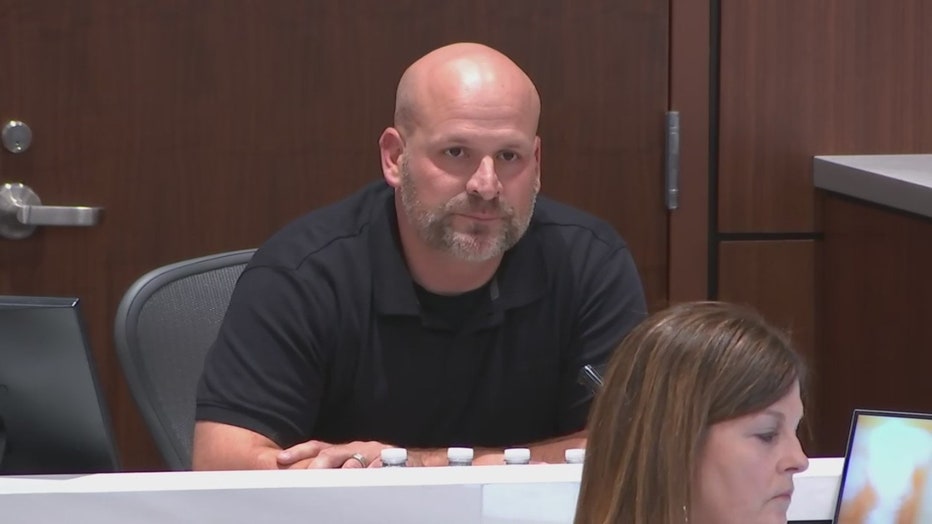
Joshua Kraner
"I instantly tried to find my son," Kraner testified, as to the moments after a red SUV drove through the parade. His son was not hurt in the incident.
Kraner said he was knocked to the ground and remembered "tires going by." He ended up in the hospital with contusions and bone bruises, he said, adding he "couldn't walk."

Joshua Kraner
Brooks asked Kraner during cross-examination, as he did Rogers, if he got a look at the SUV's driver or the license plate. Kraner said "no." Brooks also asked Kraner if he saw any reports of the "alleged defendant" in the case in the news, but the judge cut Brooks off – "next topic please" – before excusing the jury to ask Brooks why his question was relevant.
Jury excused for legal discussion
Around 11:30 a.m., the jury was excused so the court could discuss Brooks' line of questioning when cross-examining Kraner, specifically when asking Kraner about what he saw on the news. Judge Dorow asked Brooks for an offer of proof as to why the line of questioning was relevant. The judge ended the discussion by telling Brooks to ask relevant questions, and they would be answered. During the discussion, Dorow brought up Brooks' "sovereign citizen" arguments again and said she did not see a need to bring Kraner back in for further questioning.
There was then a discussion about the lunch break and what witnesses the state would be calling next. Judge Dorow wanted to keep going. The state said they would need to call a witness out of order because their other witness wasn't in court, anticipating the lunch recess.
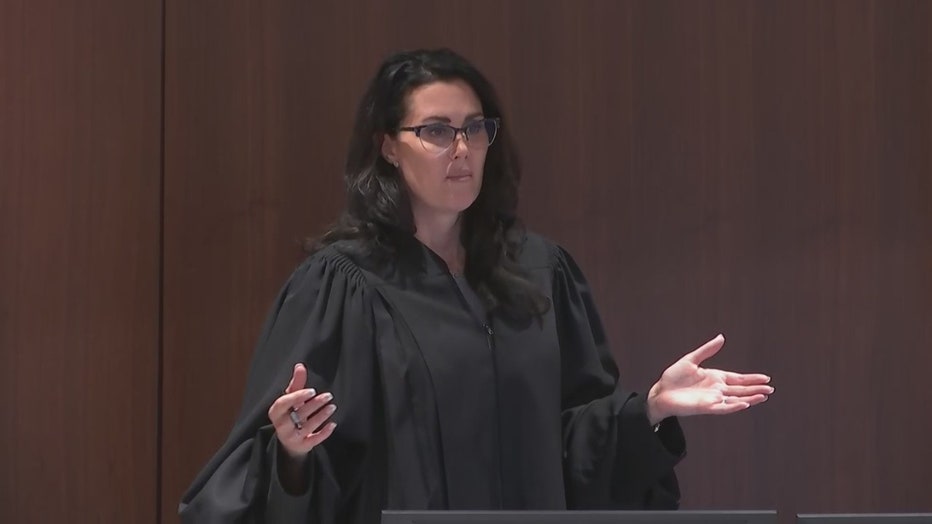
Judge Jennifer Dorow
At this point, Brooks told the judge he didn't understand what she meant by "sovereign things."
"I'm not trying to sit here... I've got enough work to do on the fly," said Brooks. "I'm not trying to sit here and anticipate what will be objected to/ruled on. It was understood this would be a whole new thing for me to do. I apologized if I'm not as polished as I should be working on three days before the trial."
Brooks was warned that the jury was coming back in. He continued with his "sovereign citizen" arguments, telling the court he did not consent to being called by that name.
Alyssa Gajewski, Xtreme Dance Team coach, testifies
The state called its fourth witness, Xtreme Dance Team Coach Alyssa Gajewski. The group she coaches, she said, are in sixth through eighth grade. Prosecutors asked Gajewski, who broke down in tears, if and why the group stopped dancing.
"There was a car that drove through," Gajewski testified. Fifteen members of her group were hit. While Gajewski said she was not hurt, she said she was walking next to the girls on her dance team who were hit.

Darrell Brooks trial: Xtreme Dance Team coach's emotional testimony
Alyssa Gajewski broke down into tears on the stand in the Darrell Brooks trial Tuesday, recalling the moments after "a car that drove through" the Waukesha Christmas parade, striking her young dancers.
Prosecutors showed Gajewski slowed-down video of the SUV driving through the parade. In that video, when asked by the state, Gajewski identified Jessalyn (Torres) – a member of Xtreme's junior dance group, who was hit and injured.
"I picked her up as soon as her body was in front of me," Gajewski said. "I didn't know if there was going to be a bunch of cars – I just wanted to get her out of the way."
Gajewski also testified about victims who were taken to the hospital and the condition they were in.

Waukesha Xtreme Dance Team
Judge Dorow dismissed the jury for lunch around 12:15 p.m.
Court addresses Brooks' hearsay objections
Before breaking for lunch, the court addressed Brooks' hearsay objections.
"Your hearsay objections are not hearsay," said Judge Dorow. "I hope you are not saying them just to interpose an objection."
Brooks asked, "How do I know that the prosecution isn't objecting to anything based on the same assumption?"
The judge reminded Brooks he has a statute book and pointed to the relevant hearsay statutes.
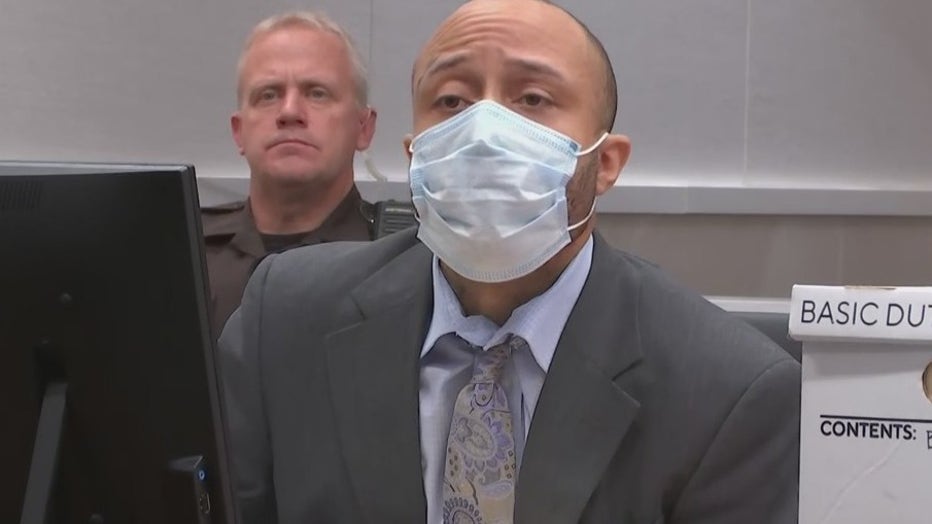
Darrell Brooks in court Tuesday, Oct. 11
"I realize you are not a lawyer, but you still should have a good faith basis for making the objection and not arguing with me when I rule on the objection," said Dorow.
The judge noted that she did sustain one of Brooks' hearsay objections because it was actually hearsay. She ended by telling Brooks that she hoped reviewing the statute would be "helpful to you as you formulate your objections. Of course, I'll keep ruling on them."
Brooks brought up another case just before the jury was brought back in related to subject matter jurisdiction. Dorow ordered him to put a motion in writing and follow proper procedure.
She told Brooks, "I've already dealt with this repeatedly." Brooks mentioned that he'd filed "several motions."
"I've already addressed it," the judge said.
Brooks cross-examines Alyssa Gajewski
On cross-examination by Brooks, Gajewski was asked about the fact that she referred to the red SUV as a car. She clarified that she saw a Ford emblem and knew it was a Ford Escape. She said she did not get a look at the driver. She estimated the SUV was going 55 miles per hour.
Brooks asked if she actually saw the SUV hit people.
"I remember seeing bodies in the air and on the ground," she said.
She added that she blacked out during the incident.
"Was that the first time you ever had a blackout?" asked Brooks.
"Yes," she said.
"Any idea what caused it?" asked Brooks.
"Stress. Shock," she said.
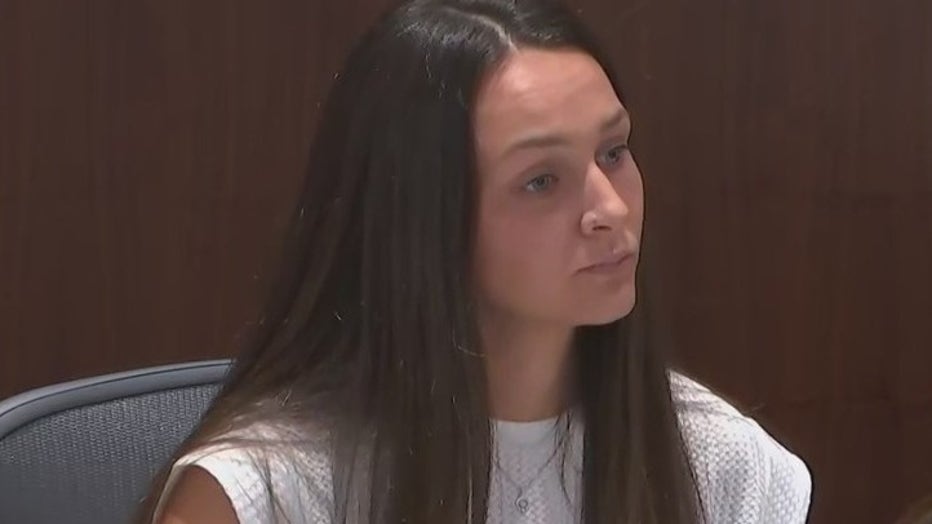
Alyssa Gajewski
On redirect, she described the scene for prosecutors: "Just pure chaos, poms everywhere, bodies, people screaming. Just chaos."
Brooks also asked about a statement she made that people were laying on the ground at the hospital.
"Any reason they were laying on the ground in the hospital?" asked Brooks.
Gajewski testified that there were so many injured people at the hospital, the nurses were doing the best they could. There was not room enough for all those injured at the hospital, she said.
Jaimie Sutton, Xtreme Dance Team coach, testifies
Next to testify was Jaimie Sutton, who worked as an Xtreme Dance Team coach in 2021 for the junior team. She said she was not injured in the incident.
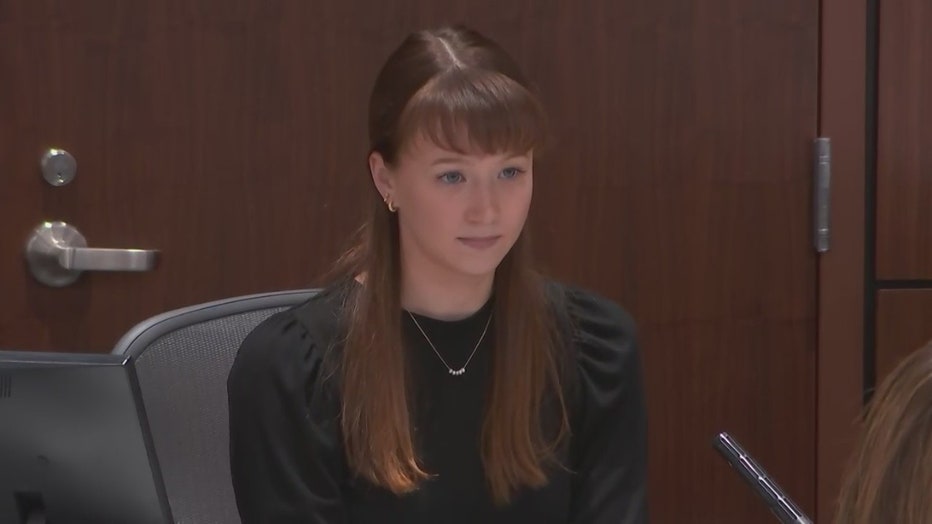
Jaimie Sutton
Sutton was shown video by ADA Zachary Wittchow, and she said, "It shows a car hitting some of our girls."
Sutton identified her dancers in the video and said she was toward the back right side of the group.
"I was in the back right with our younger teams, helping them get into formation," said Sutton. "I heard yelling, looked over my left shoulder, there was a red car. By the time I looked, it was already hitting our girls."
She said girls who weren't injured ran to the sidewalk, and she tried to reunite some with their parents. Then she said she "heard there was an active shooter," so they went into Chef Pam's Kitchen.
On cross, Brooks also asked Sutton whether she identified the vehicle as a car or an SUV.
"It was an SUV," she said. "I identify all vehicles as cars."
"At what point do you recall there was an active shooter?" asked Brooks.
"Gathering the girls, a man came up to me and said that," said Sutton.
Waukesha Police Detective Mike Carpenter testifies

Waukesha Police Detective Mike Carpenter
Next up for the state was Waukesha Police Detective Mike Carpenter, who is assigned to the computer forensics unit which involves analyzing digital data, phones, computers, etc.
"We wanted to determine if there was a way to get an accurate speed from the red SUV," said Carpenter.
He noted he's had training on this.
Investigators used two cameras from Boscos storefront and also, video from inside.
"The video, in my opinion, was pretty high quality," he said. "I could see the vehicle pretty clearly traveling westbound on West Main Street."
Carpenter testified investigators next had to determine what an accurate frame rate was for the camera. He explained how that’s done from camera to camera. They recorded a video using a light in front of each camera to be able to accurately depict their timing. He added that he also asked a police department specialist to respond to Boscos and use a 3D laser mapping device to map various points in front of the social club. They found the orientation that the eastbound camera was facing and then took a screenshot of a 3D scale that has millions of points before entering it into their software to overlay with video of what happened. He said they plotted points to match up the videos, done over a number of points, providing an identical match. Then they used the light video they recorded to match frame by frame. He said he was concerned with 25 frames as the vehicle was traveling west.
"0.834 seconds had passed in those 25 frames from that vehicle passing westbound," he said.
Once he had that, he completely overlaid the video starting at Frame 35. He said he dropped a point of reference there, on the front passenger wheel and advanced frame by frame until Frame 60, when he dropped another point to use a slider back and forth. He then took and measured the distance from the point at 35 to the point at 60, and the software told him the distance was a little more than 12 meters or 41.8231 feet.
He said they came up with a measurement of about 33-34 MPH at that point.
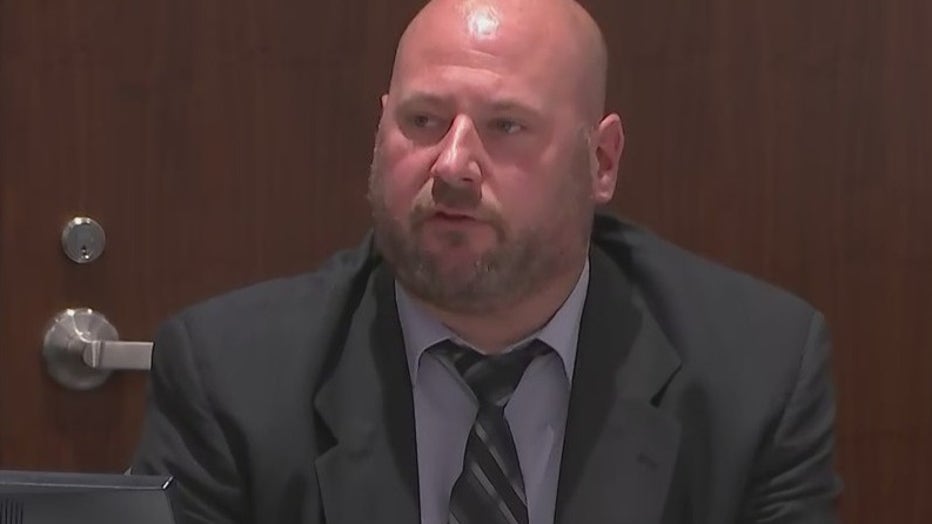
Waukesha Police Detective Mike Carpenter
Video was played, slowed down and paused. Carpenter explained the dropping of points using the video.
"I was basically measuring just how far that SUV, or that wheel, traveled in that video," he said.
Wittchow had the video played from 0:16 to 0:17, pointing out 26 frames in question were within that timeframe. Carpenter said "yes."
On cross, Brooks questioned Carpenter as to whether "sometimes, the exact timing of speed could be a little inaccurate?"
"No, I don’t believe that properly characterizes it," Carpenter said, referring to the variable frame rate of digital recording systems. "To do this the most accurate, scientific way possible. That’s why we conducted it … the way that we did."
Brooks again asked if there could be miscalculations. Carpenter said "no." Brooks clarified, asking whether there can be miscalculations with this process in general. Carpenter said by a different process, yes, "but not in this way."
Brooks asked if Carpenter had used this process before, and he said not in a live case but he had done it "a number of times." Brooks then asked the difference between a live case and any other case.
"There really is no difference. The training we use is hands-on … the way we’d do it is exactly the same," Carpenter said.
The defendant again asked whether this was the first time Carpenter used this process for a "live investigation," and Carpenter went through his list of certifications and training, which he described as "quite intensive, quite difficult."
"This was the first time I personally used the software, as our agency recently purchased it…" Carpenter said.
Brooks asked about any learning curve, and Carpenter said no. That's when Carpenter noted his more than 1,500 hours of training.
"Over that time, I developed the skills necessary to be able to start using software, using techniques to do investigations," he said.
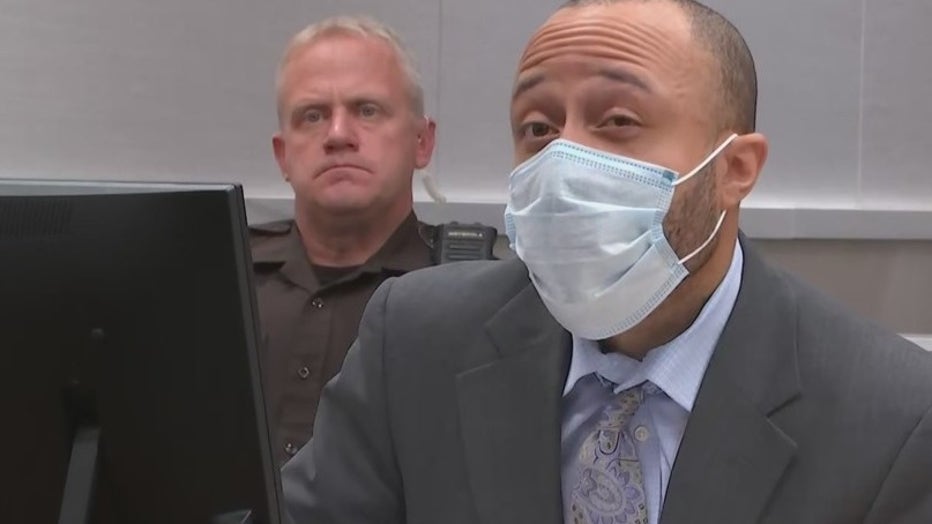
Darrell Brooks in court Tuesday, Oct. 11
Brooks also asked why this video analysis wasn't done until August.
"I believe in January, when we first started looking at this, we had to obtain funding, schedule training, wait for the company to post the training," he said.
He added that COVID increased the delay due to the availability of classes.
On redirect, Wittchow asked if Carpenter were able to take the same Boscos video recorded during the parade today and start his calculations, he would come to the same MPH conclusions. Carpenter said "yes."
Wittchow said this was not the first time Carpenter used this software, and he said "correct." Wittchow said used the software to conduct speed analysis on prior occasions as part of his training, and Carpenter said "yes." He said he was not the first person to testify in a U.S. courtroom about using this technology. He said it is used by others besides law enforcement.
Before the afternoon break, Waukesha County District Attorney Sue Opper noted they were "behind" in their case.
"Today has gone much slower than anticipated on cross," said Opper.
Debora Ramirez, Waukesha Christmas Parade attendee, testifies
Next to the stand for the state was Debora Ramirez, who lives in Waukesha and attends the parade every year.

Debora Ramirez
She was there Nov. 21, 2021 with her boyfriend, their four kids and her dad. One of those children was Isaac, 12. Ramirez said she was seated on Main Street.
Ramirez said at one point during the parade, her boyfriend yelled and screamed.
"I looked to my right, and that’s when I saw a red vehicle coming right toward us," she said. "It was a red SUV. That’s all I remember."
When asked what she did next, Ramirez said she "froze."
"By the time that I finally tried to move, it was already like, right at us, and I was hit on my left foot, left leg," she said. "It was on top of my left foot. … The tire went over my foot."
She said she was standing to the right of Isaac, who was also hit. She didn't realize it until after it happened.
"He said, ‘Mom, my leg hurts,'" said Ramirez.
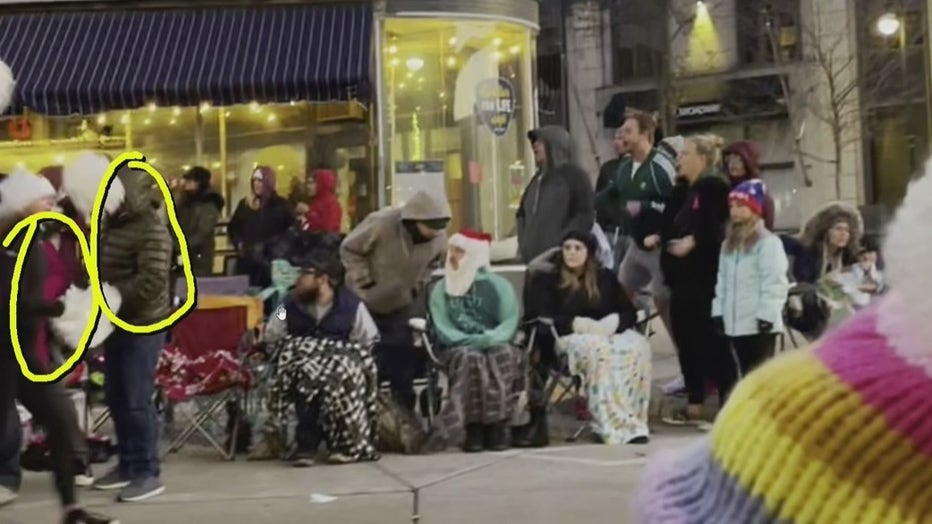
Debora Ramirez and Isaac
Ramirez said she fell to the ground and was disoriented at first.
"All I remember was hearing the vehicle speeding past, speeding past us, towards other people, and looking all around me, I just remember seeing a lot of people on the ground as I was looking around to see if my kids were OK," she said.
She said she does not remember the brakes being hit on the SUV.
"I remember hearing it accelerate instead of stopping…" she said.
She said they went to urgent care in Pewaukee the next day.
"I had a hematoma in my left big toe, and I had – my ankle was sprained," she said. "I went to see an orthopedic doctor who said that there was tissue damage."
She said Isaac sprained his left leg.
On cross, Brooks asked Ramirez why she waited until the next day to go to urgent care.
"I was trying to find my other child, who was at the parade but not like, right with me," she said.
She also said she knew how many people had been injured, including "how many people were in the ground, needing immediate help."
"I chose to wait until the next day since I knew I was hurt, but I did not need immediate attention as other people did," she said.
She added that her son was "limping" but able to "walk out of there with me," so they waited until the next day to seek medical attention.
Brooks also questioned Ramirez about her police interview, asking why it took a few days.
"We weren’t in touch right away. It just took a few days for us to set up the interview," she said.
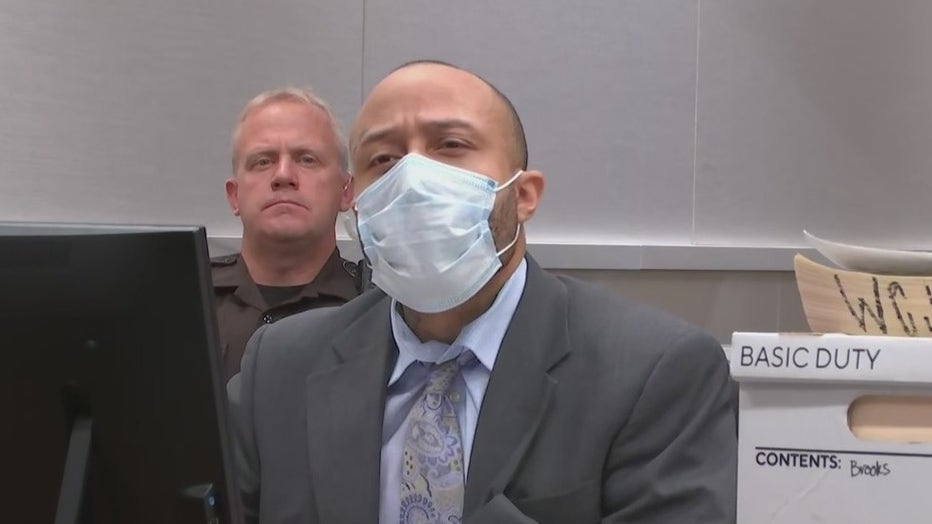
Darrell Brooks in court Tuesday, Oct. 11
Brooks asked if she sought to make a report the night of the incident. She said "no."
"I was in shock," she said, adding that when she got home, she basically had a mental breakdown and didn’t think of anything else.
The defendant asked if any of her other children were hurt.
"Just sprains from getting out of the way, but not from the vehicle," she said.
Brooks asked if she was able to estimate the speed of the vehicle.
"I wouldn’t know how fast it was traveling," she said, adding, "All I remember is that it was a red SUV. I wasn’t able to see what the make or model was."
She said she did not see the driver or the license plate number. She also said she didn't see the SUV hit anyone after it passed her.
On redirect, Wittchow asked Ramirez which group was in front of her when the SUV got to her, and she said the Waukesha Xtreme Dance Team. She said the girls got hit, and she saw the aftermath.
The jury was excused shortly before 4:30 p.m.
Brooks' 13th subpoena discussion
After that, Judge Dorow asked Brooks to explain his intent to object to an exhibit; a screenshot with comments on it. Brooks asked if they could cut it out. The judge said the jury could ask to see exhibits during deliberations, and she would make a determination at that time. Brooks said he believed she was more than clear in telling them to disregard the comments. Wittchow said Exhibit 40 was the exhibit referred to, and they put it on pause.
It was determined Brooks' witness, Juan Marquez, would be called Wednesday afternoon out of order to utilize the Spanish interpreter. Brooks was informed by the judge he would do initial questioning and the state would then cross-examine Marquez Wednesday afternoon. Marquez is on the state's witness list, but prosecutors aren't calling him.
Before the court went into recess for the night, the judge again noted Brooks did not use headphones in court Tuesday.
"Especially, as it relates to the cross-examination of Detective Carpenter, which I would say was a technical witness," said Judge Dorow.
The judge noted Brooks asked cogent questions in cross-examination.
"I just wanted to put that on the record, and I commend you for that," the judge said.
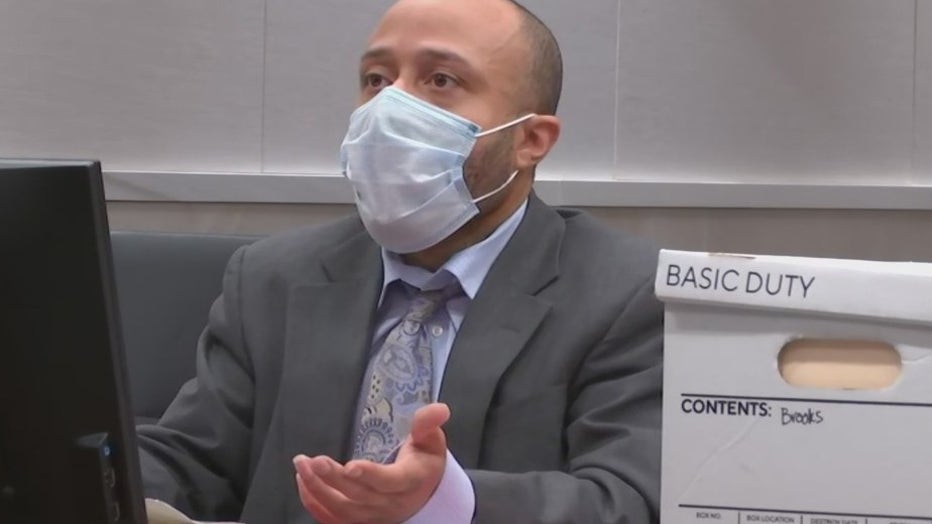
Darrell Brooks in court Tuesday, Oct. 11
Brooks said the reason was because he had been in the main courtroom Monday and Tuesday, as opposed to the first week of the trial when he was moved back and forth. He called his presence in the main courtroom for two days "a breath of fresh air." The judge agreed.
Brooks then brought up his 13th subpoena for the parade organizer who now lives out of state. Judge Dorow again told Brooks the state isn’t obligated to make any travel arrangements or serve an out-of-state subpoena.
"This is one of those things I’d refer you back to when we went through the waiver of right to an attorney form…" said Dorow, noting that travel arrangements "fall on you."
"I intended to have 13 witnesses, so if I’m not obviously not going to have my 13th witness… how am I supposed to have my 13th witness?" asked Brooks.
The judge said Brooks would be allowed to fill out another subpoena for a 13th witness, and she would address this first thing Wednesday.
The court went into recess for the night around 4:35 p.m.

Darrell Brooks trial; prosecution's Oct. 11 witnesses
In the trial of Darrell Brooks, the man charged in the Waukesha Christmas Parade attack, the prosecution called eight witnesses to testify Tuesday, Oct. 11.
FREE DOWNLOAD: Get breaking news alerts in the FOX6 News app for iOS or Android
Christmas parade attack
Prosecutors say Brooks drove a red SUV through the parade route on Nov. 21, 2021, killing six and injuring more than 60 others.
On Nov. 21, 2021, according to prosecutors, Brooks met up with his ex-girlfriend in Frame Park, the same woman he is accused of running over with his red SUV earlier in November 2021. She told police they argued in his SUV before he started driving, and he "was driving around with one hand and striking her in the face with his other hand." She eventually got out and called her friends for help.
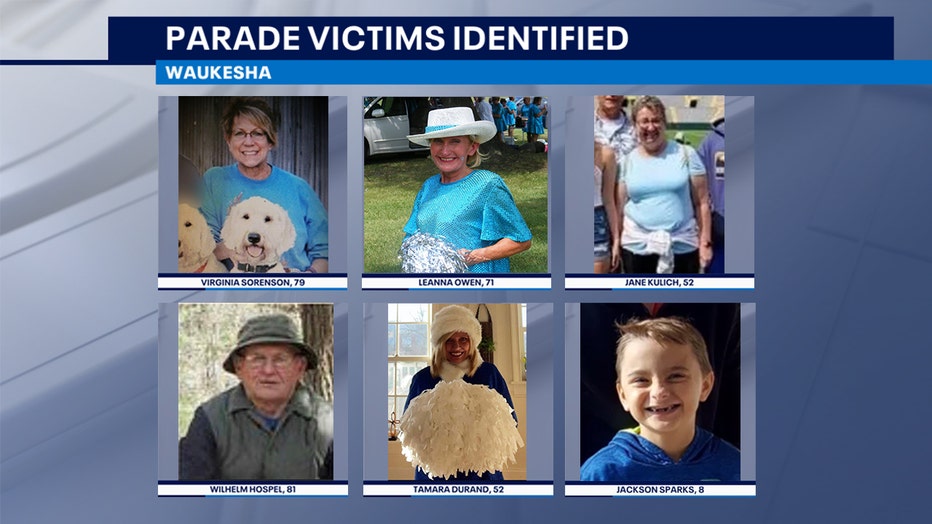
Waukesha parade attack victims identified
Soon after that, according to prosecutors, Brooks drove that red SUV through the parade route, killing Jackson Sparks, 8, Virginia Sorenson, 79, LeAnna Owen, 71, Tamara Durand, 52, Jane Kulich, 52 and Wilhelm Hospel, 81. More than 60 others were hurt.

